Blog & Latest Updates
Fly Fishing Articles
Insects by Common Name


Insect Order Trichoptera (Caddisflies)
Taxonomic Navigation -?-
Kingdom
Animalia (Animals)
» Phylum
Arthropoda (Arthropods)
» Class
Insecta (Insects)
» Order Trichoptera (Caddisflies)
5 families aren't included.
Common Name
| Match | Common Name |
| Caddisflies |
This is page 4 of specimens of Trichoptera. Visit the main Trichoptera page for:
- The behavior and habitat of Trichoptera.
- 55 underwater pictures of Trichoptera.
Pictures of 129 Caddisfly Specimens:
Apatania (Early Smoky Wing Sedges) Caddisfly Adult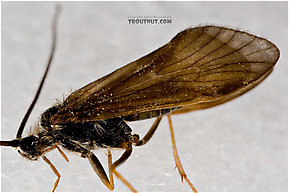 View 8 Pictures
View 8 Pictures
 View 8 Pictures
View 8 PicturesCollected May 13, 2007 from the West Branch of the Delaware River in New York
Added to Troutnut.com by Troutnut on May 18, 2007
Added to Troutnut.com by Troutnut on May 18, 2007
Female Dicosmoecus atripes (October Caddis) Caddisfly Adult View 6 PicturesThis specimen is 26 mm.
View 6 PicturesThis specimen is 26 mm.
- Entoman
 View 6 PicturesThis specimen is 26 mm.
View 6 PicturesThis specimen is 26 mm.- Entoman
Collected September 27, 2013 from the St. Joe River in Idaho
Added to Troutnut.com by Entoman on September 29, 2013
Added to Troutnut.com by Entoman on September 29, 2013
Male Dolophilodes distinctus (Tiny Black Gold Speckled-Winged Caddis) Caddisfly Adult View 6 PicturesThis caddis species was dancing high over the stream, spaced a foot or two apart across most of its width, very much like Ephemera mayfly spinners but with more side-to-side motion mixed in. There were more than enough to get the trout interested, but I wasn't able to stick around until they fell on the water (if they did at all).
View 6 PicturesThis caddis species was dancing high over the stream, spaced a foot or two apart across most of its width, very much like Ephemera mayfly spinners but with more side-to-side motion mixed in. There were more than enough to get the trout interested, but I wasn't able to stick around until they fell on the water (if they did at all).
 View 6 PicturesThis caddis species was dancing high over the stream, spaced a foot or two apart across most of its width, very much like Ephemera mayfly spinners but with more side-to-side motion mixed in. There were more than enough to get the trout interested, but I wasn't able to stick around until they fell on the water (if they did at all).
View 6 PicturesThis caddis species was dancing high over the stream, spaced a foot or two apart across most of its width, very much like Ephemera mayfly spinners but with more side-to-side motion mixed in. There were more than enough to get the trout interested, but I wasn't able to stick around until they fell on the water (if they did at all).Collected May 28, 2007 from Mystery Creek #42 in Pennsylvania
Added to Troutnut.com by Troutnut on June 4, 2007
Added to Troutnut.com by Troutnut on June 4, 2007
Lepidostoma (Little Brown Sedges) Little Brown Sedge Larva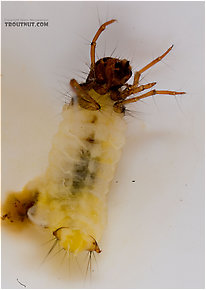 View 6 PicturesThis one got a little bit damaged in the abdomen when I extracted it from its case. That's a delicate job.
View 6 PicturesThis one got a little bit damaged in the abdomen when I extracted it from its case. That's a delicate job.
 View 6 PicturesThis one got a little bit damaged in the abdomen when I extracted it from its case. That's a delicate job.
View 6 PicturesThis one got a little bit damaged in the abdomen when I extracted it from its case. That's a delicate job.Collected May 6, 2007 from Mongaup Creek in New York
Added to Troutnut.com by Troutnut on May 18, 2007
Added to Troutnut.com by Troutnut on May 18, 2007
Limnephilus (Summer Flier Sedges) Caddisfly Larva View 4 Pictures
View 4 Pictures
 View 4 Pictures
View 4 PicturesCollected January 14, 2004 from unknown in Wisconsin
Added to Troutnut.com by Troutnut on January 25, 2006
Added to Troutnut.com by Troutnut on January 25, 2006
Rhyacophila brunnea (Green Sedge) Caddisfly Larva View 4 Pictures
View 4 Pictures
 View 4 Pictures
View 4 PicturesCollected February 7, 2004 from unknown in Wisconsin
Added to Troutnut.com by Troutnut on January 25, 2006
Added to Troutnut.com by Troutnut on January 25, 2006
Hydropsyche californica (Spotted Sedge) Caddisfly Larva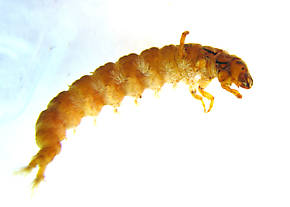 View 5 PicturesSize - 14 mm
View 5 PicturesSize - 14 mm
Condition - preserved
Habitat - cobble bottom, moderate flow run, at a depth of approx. 1 1/2 feet.
Key Characters - pair of large prosternal sclerites (Sclerite: A hard plate of chitinous material, such as those that form the exoskeletons of arthropods, uninterrupted by cracks or sutures.)
This is a very common taxon at this location. I collected using a kick net. In life, it is bright olive green ventrally, shading to a dull olive at its dorsal (Dorsal: Top.) abdominal surfaces. In the hand, the legs, thoraxic regions, and head appear medium chocolate brown. The stark contrast of the thoraxic plate's dark edges and light legs are effects of preserving. The plumouse anal hooks were duck down gray, not the color of the gills as appears in the preserved specimen.
The Lower Yuba River is a good habitat for this species, being a larger river with an open canopy. The Feather River just to the north of the Yuba system also finds H. californica in abundance. The other common Hydropsyche species in the area, Hydropsyche occidentalis, seems to prefer smaller, shaded streams.
Entoman
 View 5 PicturesSize - 14 mm
View 5 PicturesSize - 14 mmCondition - preserved
Habitat - cobble bottom, moderate flow run, at a depth of approx. 1 1/2 feet.
Key Characters - pair of large prosternal sclerites (Sclerite: A hard plate of chitinous material, such as those that form the exoskeletons of arthropods, uninterrupted by cracks or sutures.)
This is a very common taxon at this location. I collected using a kick net. In life, it is bright olive green ventrally, shading to a dull olive at its dorsal (Dorsal: Top.) abdominal surfaces. In the hand, the legs, thoraxic regions, and head appear medium chocolate brown. The stark contrast of the thoraxic plate's dark edges and light legs are effects of preserving. The plumouse anal hooks were duck down gray, not the color of the gills as appears in the preserved specimen.
The Lower Yuba River is a good habitat for this species, being a larger river with an open canopy. The Feather River just to the north of the Yuba system also finds H. californica in abundance. The other common Hydropsyche species in the area, Hydropsyche occidentalis, seems to prefer smaller, shaded streams.
Entoman
Collected March 9, 2011 from the Lower Yuba River in California
Added to Troutnut.com by Entoman on November 2, 2011
Added to Troutnut.com by Entoman on November 2, 2011
Lepidostoma (Little Brown Sedges) Little Brown Sedge Larva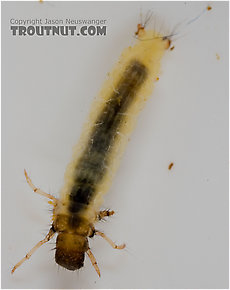 View 6 Pictures
View 6 Pictures
 View 6 Pictures
View 6 PicturesCollected May 13, 2007 from the Delaware River in New York
Added to Troutnut.com by Troutnut on May 18, 2007
Added to Troutnut.com by Troutnut on May 18, 2007
Female Dolophilodes distinctus (Tiny Black Gold Speckled-Winged Caddis) Caddisfly Adult View 6 PicturesThis is a really strange specimen. I would guess it's one of the dry caddis pupa that scoots across the surface of the water as a pupa rather than emerging right away. Its "wing pads (
View 6 PicturesThis is a really strange specimen. I would guess it's one of the dry caddis pupa that scoots across the surface of the water as a pupa rather than emerging right away. Its "wing pads (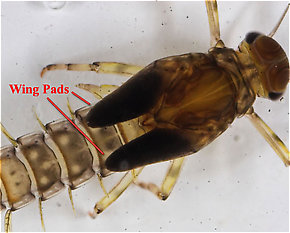 Wing pad: A protrusion from the thorax of an insect nymph which holds the developing wings. Black wing pads usually indicate that the nymph is nearly ready to emerge into an adult.)" sure don't look right, though. Maybe they're deformed and that's why I was able to find this one as a pupa in the first place. It also looks like it might be a caddis adult missing its wings, but since I found three of them, that kind of rules out such an anomalous maiming.
Wing pad: A protrusion from the thorax of an insect nymph which holds the developing wings. Black wing pads usually indicate that the nymph is nearly ready to emerge into an adult.)" sure don't look right, though. Maybe they're deformed and that's why I was able to find this one as a pupa in the first place. It also looks like it might be a caddis adult missing its wings, but since I found three of them, that kind of rules out such an anomalous maiming.
I found this one and one other on a midstream rock. The previous day, I caught a similar creature kicking around on the water's surface.
This one died and shriveled a little bit before I could photograph it, but it's basically in its original shape.
 View 6 PicturesThis is a really strange specimen. I would guess it's one of the dry caddis pupa that scoots across the surface of the water as a pupa rather than emerging right away. Its "wing pads (
View 6 PicturesThis is a really strange specimen. I would guess it's one of the dry caddis pupa that scoots across the surface of the water as a pupa rather than emerging right away. Its "wing pads (
The wing pads on this final instar Baetidae mayfly nymph are extremely dark.
I found this one and one other on a midstream rock. The previous day, I caught a similar creature kicking around on the water's surface.
This one died and shriveled a little bit before I could photograph it, but it's basically in its original shape.
Collected May 29, 2007 from Brodhead Creek in Pennsylvania
Added to Troutnut.com by Troutnut on June 4, 2007
Added to Troutnut.com by Troutnut on June 4, 2007
Dolophilodes distinctus (Tiny Black Gold Speckled-Winged Caddis) Caddisfly Larva View 4 Pictures
View 4 Pictures
 View 4 Pictures
View 4 PicturesCollected February 7, 2004 from unknown in Wisconsin
Added to Troutnut.com by Troutnut on January 25, 2006
Added to Troutnut.com by Troutnut on January 25, 2006
Top 10 Fly Hatches
Top Gift Shop Designs
Eat mayflies.
Top Insect Specimens
Miscellaneous Sites
Troutnut.com is copyright © 2004-2024 Jason
Neuswanger (email Jason). See my FAQ for information about use of my images.
 privacy policy
privacy policy
